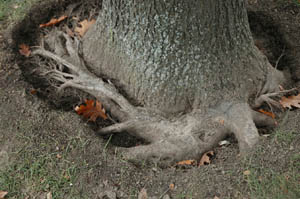Deep Planting and Girdling Roots Still a Problem | |
|---|---|
| May 8, 2006 | |
|
For several years now, I have been warning of the woes of planting trees too deeply. I have explained that we need to locate the first major root coming off the trunk and place it just below the soil line. A flare of the trunk should be visible above the soil line. It is really a pretty simple concept: Roots are below ground, and everything else is above the ground. I have a few stressed-looking trees in my yard. Last fall, my arborist did root collar excavations on these trees to assess the possibility of girdling roots and signs of deep planting. All of the trees had one or both problems. Image 060404 shows the base of my red oak tree with collar exposed.  I was surprised at our findings because my trees are all about 25 years old and I thought I would see the consequences of deep planting much earlier in the life of the tree. My arborist pointed out that it often takes that long for roots growing around the tree to become girdling. He also pointed out that trees that are planted too deeply can limp along for many, many years. I did not plant the trees, so I am not going to take the blame for this problem, but I have to put up with the consequences. The message to remember is to make certain that you are planting trees correctly. You would be surprised at how many so called “diseased trees” are actually those stressed by deep planting and girdling roots. Diagnosing tree problems can be rewarding, but often frustrating, because we often see only a part of the problem. Besides observing leaves and stems, it is helpful to see the entire tree, the pattern of injury, the condition of surrounding plants, the lay of the land, and the activities that go on around a tree. At this time of year, we see tree twig dieback and leaf spotting commonly at the Plant Clinic. Observing branch terminals helps us determine how long the tree has been stressed. You can make this observation, too. The idea is to look at stem growth in length over several years. The terminal bud each year leaves a scar on the stem, seen as multiple rings around the stem, as if a rubberband had been tightly wrapped at that point. Distance between terminal bud scars from two successive years is the amount of growth for that year. Multiple years of 1 to 2 inches of stem growth clearly indicate a stressed tree. Compare growth of shady areas of the tree with sunny areas to get a true picture of growth. Often tree identification books such as Dirr’s Manual of Woody Landscape Plants indicate a normal amount of growth for a species. Many deciduous tree samples we receive at the clinic show scorching, wind tatter, and perhaps cold injury. Often, these same trees exhibit poor stem growth for at least the last 3 to 5 years. Follow-up questioning and photographs of the lower trunk frequently show the tree was planted too deeply. Deep planting can cause slow decline over many years. It may not kill the tree but does not allow it to thrive. Does a tree that is planted too deeply need to be removed? That is not usually the case, but arborists to help the tree grow better. Deep planting is a major problem in our landscapes and one that is completely avoidable. The International Society of Arboriculture (ISA) created www.treesaregood.com to provide high-quality information on tree care to the public. A section on planting new trees explains the planting process and has a helpful diagram to illustrate major points. One crucial mistake often made in planting is placing the root ball in the soil exactly as it came from the nursery. Because nurseries use cultivation to cut down on weeds (and avoid herbicides), and becausue cultivation often throws soil up around the base of the tree, some of this soil may need to be removed before planting. Identify the trunk flare (where the roots cause the trunk to widen) and be certain this flare is partially visible when the tree is planted. The tree should be planted so the first root is just below the soil surface. Do not bury this flare with mulch once the tree is planted. Other details such as digging the correct hole, mulching, and follow-up care are discussed on the ISA Web site. Taking the time to plant your tree correctly helps ensure its health for years to come. Deep planting causes years of tree decline and frustration in tree care. Now, I know from experience. |